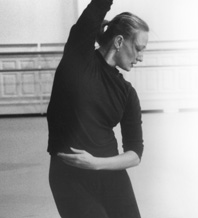Dance Review: SOLO: Live to Dance/Dance to Live
Natalie Harter ventures to the Southern Theater for SOLO, performances by the 2002 and 2003 McKnight Artist Fellowship recipients in dance, to see whats possible when dancers are paid for their passion.

For so many artists, art equals life, and yet art so very rarely equals livelihood. We hate to muddy up the arts with money. Art is supposed to be separate somehow, above and beyond the earthly things of this world. Artists are told their art should be reward enough. After all, if it’s their passion, they shouldn’t expect monetary compensation for it, should they?
Most dancers have a “real” job, often full time, in addition to teaching, taking classes, and rehearsing and performing for one or more companies. That kind of schedule leaves very little room for experimenting and creating, and all kinds of room for fragmentation and burnout. It’s pretty damn hard to live as a dancer without money and the time and space to create that money affords. Hardly an original idea (didn’t Virginia Woolf put it forth some 50 years ago…?), but one we’re still working to realize.
So what would a dancer’s life be like if they were paid for their art? And I mean really paid, not just a performance percentage here and there…?
Enter SOLO. As the culmination of six fellowships awarded by the McKnight Foundation over the past two years, SOLO presents the dancer fellows in original works commissioned for them by a choreographer of their choosing. A dancer’s dream come true, right? But wait, that’s just the icing… The cake is a hefty chunk of money that enabled each dancer to spend a year dancing. It’s no surprise that each work is striking, original, and pitch perfect.
I can’t tie these six performances together in a tidy bundle, because the exciting thing about them is that they are all so personal and and unique. But I can say that boundaries are pushed in each, and I’m not talking genre boundaries (in fact, there’s very little genre work here, each piece is splendidly barefoot and postmodern). I’m talking literal boundaries, from the edges of furniture in Joanne Spencer’s “Interior Design,” to the edges of constricting shafts of light and societal rules in Leah Nelson’s “YOUR Place,” and even the perilous edge of a bird’s nest in Wynn Fricke’s “Nestling.”
In the shortest but most explosive work presented, Megan McClellan pushes the boundaries of the space/time continuum itself. She’s a flash of light, here and then gone. Choreographed by Alvin Ailey alum Uri Sands in “Work XX: ‘From Ashes,’” McClellan leaps and rolls and runs across the stage, a blur of braids and legs clad in red velvet, like the mythological phoenix arising from the ash only to die again in the flame.
Pushing more boundaries is the incredible lighting design of Jeff Bartlett. The use of light in each piece is so evocative it becomes an element absolutely necessary to the story the dancer is telling. In Susie Bracken’s exquisitely haunting “by a thread” the light comes down from above in watery circles, situating Bracken at the bottom of a well or oubliette. She contorts around like a mermaid trying to free herself of her tail, until she is at last seized by a spotlight.
The unforgiving and lifeless light in Eric Boone’s “The Center Shifts” is part of the reason the piece is the least aesthetically pleasing to me, but then that’s the point. Attired in unassuming shades of gray, Boone moves on and around office furniture (echoing back to the first piece by Spencer, while retaining none of its warmth and wonder). It’s a sadly fitting way to end the program, evoking the tyranny of a desk job. Boone executes the piece brilliantly, causing me to shift in my seat as he forcibly restrains his body’s natural impulses to move in order fit in a proscribed space.
One can only hope, after seeing what’s possible, that these dancers don’t resign themselves to such a fate.
For video clips of the performances, go to: http://www.southerntheater.org/pages/mcknight_dancer_fellows_04_30_2004.html
For more information on the McKnight Fellowship program, go to:
http://www.southerntheater.org/pages/fellowship.html